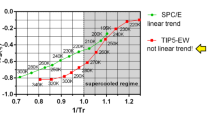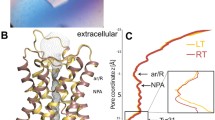Abstract
Structure and dynamics of a free aquaporin (AQP1) are studied by a coarse-grained Monte Carlo simulation as a function of temperature using a phenomenological potential with the input of a knowledge-based residue–residue interaction. Response of the radius of gyration (R g) of the protein to the temperature (T) is found to be nonlinear: Decay of R g at T ≤ T c is followed by a continuous increase at T ≥ T c before reaching its saturation. In thermo-responsive regime, the protein exhibits segmental globularization with the persistence of three regions along its sequence involving residues 1M–25V and 250V–269K toward the beginning and end segments with a narrow intermediate region around 155A–163D. A detail analysis of the structure factor S(q) shows a global random coil conformation at high temperatures with an effective dimension D e ~ 1.74 and a globular structure (D e ~ 3) at low temperatures. In thermo-responsive regime, the variation of S(q) with the wave vector q reveals a systematic redistribution of self-organizing residues (in globular and fibrous sections) that depends on the length scale and the temperature.







Similar content being viewed by others
References
Papadopoulos MC, Saadoun S (2015) Key roles of aquaporins in tumor biology. Biochim Biophys Acta. doi:10.1016/j.bbamem.2014.09.001
Kumar M, Grzelakowski M, Zilles J, Clark M, Meier W (2007) Highly permeable polymeric membranes based on the incorporation of the functional water channel protein Aquaporin Z. Proc Natl Acad Sci USA 104:20719–20724
Wang J, Feng L, Zhu Z, Zheng M, Wang D, Chen Z, Sun H (2015) Aquaporins as diagnostic and therapeutic targets in cancer: how far we are? J Transl Med 13:96
To J, Torres J (2015) Can stabilization and inhibition of aquaporins contribute to future development of biomimetic membranes? Membranes 5:352–368
Boassa D, Stamer WD, Yool AJ (2006) Ion channel function of aquaporin-1 natively expressed in choroid plexus. J Neurosci 26:7811–7819
Ash WL, Zlomislic MR, Oloo EO, Tieleman DP (2004) Computer simulations of membrane proteins. Biochim Biophys Acta 1666:158–189
Kong Y, Ma J (2001) Dynamic mechanisms of the membrane water channel aquaporin-1 (AQP1). PNAS 98:14345–14349
Wang Y, Tajkhorshid E (2007) Molecular mechanisms of conduction and selectivity in aquaporin water channels. J Nutr 137:1509S–1515S
Jensen MO, Mouritsen OG (2006) Single-channel water permeabilities of Escherichia coli aquaporins AqpZ and GlpF. Biophys J 90:2270–2284
Hashido M, Kidera A, Ikeguchi M (2007) Water transport in aquaporins: osmotic permeability matrix analysis of molecular dynamics simulations. Biophys J 93:373–385
Hashido M, Ikeguchi M, Kidera A (2005) Comparative simulations of aquaporin family: AQP1, AQPZ, AQP0 and GlpF. FEBS Lett 579:5549–5552
Gumbart J, Wang Y, Aksimentiev A, Tajkhorshid E, Schulten K (2005) Molecular dynamics simulations of proteins in lipid bilayers. Curr Opin Struct Biol 15:423–431
Yu J, Yool AJ, Schulten K, Tajkhorshid E (2006) Mechanism of gating and ion conductivity of a possible tetrameric pore in aquaporin-1. Structure 14:1411–1423
Bond PJ, Holyoake J, Ivetac A, Khalid S, Sansom MSP (2007) Coarse-grained molecular dynamics simulations of membrane proteins and peptides. J Struct Biol 157:593–605
Lindahl E, Sansom MSP (2008) Membrane proteins: molecular dynamics simulations. Curr Opin Struct Biol 18:425–431
Lyubartsev AP, Laaksonen A (1995) Calculation of effective interaction potential from radial distribution functions: a reverse Monte Carlo approach. Phys Rev E 52:3730–3737
Zhou J, Chen S, Jiang S (2003) Orientation of adsorbed antibodies on charged surfaces by computer simulation based on a united-residue model. Langmuir 19:3472–3478
van Giessen AE, Straub JE (2005) Mote Carlo simulations of polyalanine using a reduced model and statistics-based interaction potential. J Chem Phys 122:0249041–0249049
Reith D, Putz M, Muller-Plathe F (2003) Deriving effective mesoscale potentials from atomistic simulations. J Comput Chem 24:1624
Pandey RB, Farmer BL (2010) Global structure of a human immunodeficiency virus-1 protease (1DIFA dimer) in an effective solvent medium by a Monte Carlo simulation. J Chem Phys 132:125101–125106
Liwo A, Czaplewski C, Oldziej S, Scheraga HA (2008) Computational techniques for efficient conformational sampling of protein. Curr Opin Struct Biol 18:134–139
Ercolessi F, Adams J (1994) Interatomic potentials from first-principle calculations: the force-matching method. Europhys Lett 26:583–588
Zhou J, Thorpe IF, Izvekov S, Voth GA (2007) Coarse-grained peptide modeling using a systematic multiscale approach. Biophys J 92:4289–4303
de Jong DH, Singh G, Drew Bennett WF, Arnarez C, Wassenar TA et al (2013) Improved parameters for the martini coarse-grained protein force field. J Chem Theory Comput 9:687–697
Sorensen J, Xavier P, Skeby KK, Marrink SJ, Schiott B (2011) Protofibrillar assembly towards the formation of amyloid fibrils. J Phys Chem Lett 2:2385–2390
Haliloglu T, Bahar I (1998) Coarse-grained simulations of conformational dynamics of proteins: application to apomyoglobin. Proteins 31:27–281
Pandey RB, Farmer BL, Gerstman BS (2015) Self-assembly dynamics for the transition of a globular aggregate to a fibril network of lysozyme proteins via a coarse-grained Monte Carlo simulation. AIP Adv 5:092502-1–092502-12
Mirau P, Farmer BL, Pandey RB (2015) Structural variation of alpha-synuclein with temperature by a coarse-grained approach with knowledge-based interactions. AIP Adv 5:092504-1–092504-10
Tanaka S, Scheraga HA (1976) Medium and long range interaction parameters between amino acids for predicting three dimensional structures of proteins. Macromolecules 9:945–950
Miyazawa S, Jernigan RL (1985) Estimation of effective inter residue contact energies from protein crystal structures: quasi-chemical approximation. Macromolecules 18:534–552
Miyazawa S, Jernigan RL (1996) Residue–residue potentials with a favorable contact pair term for simulation and treading. J Mol Biol 256:623–644
Betancourt MR, Thirumalai D (1999) Pair potentials for protein folding: choice of reference states and sensitivity of predicted native states to variations in the interaction schemes. Protein Sci 2:361–369
Godzik A, Kolinski A, Skolnick J (1996) Knowledge-based potentials for protein folding: what can we learn from protein structures? Proteins 4:363–366
Huang S-Y, Xiaoqin Z (2011) Statistical mechanics-based method to extract atomic distance-dependent potentials from protein structures. Proteins 79:2648–2661
Fritsche M, Pandey RB, Farmer BL, Heermann D (2012) Conformational temperature-dependent behavior of a histone h2ax: a coarse-grained Monte Carlo approach via knowledge-based interaction potentials. PLoS ONE 7:e32075-1–e32075-8
Pandey RB, Farmer BL (2012) Random coil to globular thermal response of a protein (H3.1) with three knowledge-based coarse-grained potentials. PLoS ONE 7:e49352-1–e49352-9
Pandey RB, Farmer BL (2013) Conformational response to solvent interaction and temperature of a protein (histone h3.1) by a multi-grained Monte Carlo simulation. PLoS ONE 8:e76069-1–e76069-9
Binder K (ed) (1995) Monte Carlo and molecular dynamics simulations in polymer science. Oxford University Press, Oxford
Acknowledgments
We thank Minttu Virkki for suggesting us to look at AQP1.
Author information
Authors and Affiliations
Corresponding author
Rights and permissions
About this article
Cite this article
Pandey, R.B., Farmer, B.L. Structure and dynamics of a free aquaporin (AQP1) by a coarse-grained Monte Carlo simulation. Struct Chem 28, 625–633 (2017). https://doi.org/10.1007/s11224-016-0836-4
Received:
Accepted:
Published:
Issue Date:
DOI: https://doi.org/10.1007/s11224-016-0836-4




